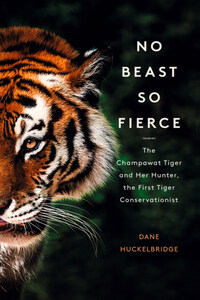COPYRIGHT
William Collins
An imprint of HarperCollinsPublishers 1 London Bridge Street London SE1 9GF WilliamCollinsBooks.com
This eBook first published in Great Britain by William Collins in 2019
First published in the United States by William Morrow, an imprint of HarperCollinsPublishers in 2019 as No Beast So Fierce: The Terrifying True Story of the Champawat Tiger, the Deadliest Animal in History
Copyright © Dane Huckelbridge 2019
Dane Huckelbridge asserts the moral right to be identified as the author of this work.
Cover image © Getty Images
A catalogue record for this book is available from the British Library.
All rights reserved under International and Pan-American Copyright Conventions. By payment of the required fees, you have been granted the non-exclusive, non-transferable right to access and read the text of this e-book on-screen. No part of this text may be reproduced, transmitted, downloaded, decompiled, reverse engineered, or stored in or introduced into any information storage and retrieval system, in any form or by any means, whether electronic or mechanical, now known or hereinafter invented, without the express written permission of HarperCollins.
Source ISBN: 9780008331726
Ebook Edition © February 2019 ISBN: 9780008331740
Version: 2019-01-29
Praise for No Beast So Fierce
“A great tale and study of man versus beast, or rather, beast versus man. The seminal battle between Jim Corbett and the Champawat Tiger stands as an epic encounter of the ages. Dane Huckelbridge’s No Beast So Fierce will make you rethink your position in God’s universe—and on the food chain.”
JIM DEFELICE, #1 bestselling co-author of American Sniper
“I had a feeling this book would hook me from the get-go. I was right. No Beast So Fierce is much more than a cautionary tale of the Man-Eater of Champawat, a Royal Bengal tiger responsible for hundreds of deaths in Nepal and India, or, of Edward James Corbett, the legendary hunter who shot and killed the big cat in 1907. Dane Huckelbridge’s remarkable narrative also reveals the circumstances that cause tigers to stalk human prey as well as Corbett’s transformation into a conservationist and ardent champion for protecting the animals he once hunted.”
MICHAEL WALLIS, author of The Best Land Under Heaven
“A gripping page-turner that also conveys broader lessons about humanity’s relationship with nature.” Publisher’s Weekly
Praise for Bourbon by Dane Huckelbridge
|
“Complex and entertaining”
| Wall Street Journal |
|
“Engrossing”
| Washington Post |
|
“Definitive”
| Sacramento Bee |
No beast so fierce but knows some touch of pity. But I know none, and therefore am no beast.
— William Shakespeare, Richard III
Do not blame God for having created the tiger, but thank Him for not having given it wings.
— Indian proverb
PROLOGUE
We do not know the year. Nor does history record the poacher’s name. But around the turn of the twentieth century, somewhere in the terai near the Kanchanpur District of western Nepal, a man made a terrible mistake.
He attempted to kill a Bengal tiger.
We can imagine him to be a young man—that seems all but certain. For the local Tharu people are well acquainted with tigers, and only a youthful and inexperienced hunter would be so careless. After all, a tiger hunt among the Tharu is a solemn affair, to be initiated with a puja sacrifice of roosters and goats, as a show of respect to the forest deity Ban Dhevi. It is an act of profound spiritual and earthly significance, one that risks angering gods and kings alike. If such a decision is to be even considered, it must be blessed by a gurau with a sacred glass of rakshi, and sanctified by the wearing of holy red ribbons.
But change is coming, even to this remote province. Like others of his generation, this brash young man likely may have tasted the British gin and cigarettes that come smuggled across the border from India, and seen the Western suits and cravats one can purchase beyond the Sharda River, and he has no time for rice liquor or garlands made of ribbons. He does not see the tiger as a divine spirit, a lord of the forest, a custodian of the natural world, maintaining the balance of all things. To him, a tiger is a sack of gold and nothing more: money for clearing land, funds to buy a water buffalo and start a farm of his own. The young man bristles at the thought of eking out a living from the forest like his parents, of dwelling in a mud-walled house thatched with elephant grass. No, that is simply not for him.









